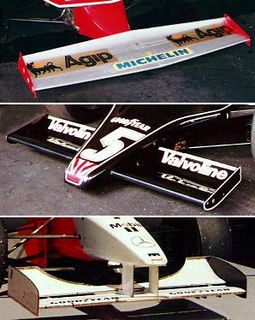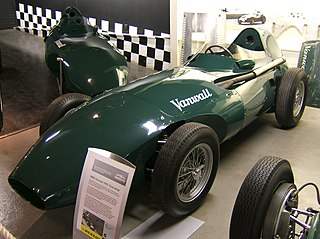
Aerodynamics, from Greek ἀήρ aero (air) + δυναμική (dynamics), is the study of motion of air, particularly as interaction with a solid object, such as an airplane wing. It is a sub-field of fluid dynamics and gas dynamics, and many aspects of aerodynamics theory are common to these fields. The term aerodynamics is often used synonymously with gas dynamics, the difference being that "gas dynamics" applies to the study of the motion of all gases, and is not limited to air. The formal study of aerodynamics began in the modern sense in the eighteenth century, although observations of fundamental concepts such as aerodynamic drag were recorded much earlier. Most of the early efforts in aerodynamics were directed toward achieving heavier-than-air flight, which was first demonstrated by Otto Lilienthal in 1891. Since then, the use of aerodynamics through mathematical analysis, empirical approximations, wind tunnel experimentation, and computer simulations has formed a rational basis for the development of heavier-than-air flight and a number of other technologies. Recent work in aerodynamics has focused on issues related to compressible flow, turbulence, and boundary layers and has become increasingly computational in nature.

In aeronautics, a chord is the imaginary straight line joining the leading edge and trailing edge of an aerofoil. The chord length is the distance between the trailing edge and the point where the chord intersects the leading edge. The point on the leading edge used to define the chord may be either the surface point of minimum radius or the surface point that maximizes chord length.
The center of pressure is the point where the total sum of a pressure field acts on a body, causing a force to act through that point. The total force vector acting at the center of pressure is the value of the integrated vectorial pressure field. The resultant force and center of pressure location produce equivalent force and moment on the body as the original pressure field. Pressure fields occur in both static and dynamic fluid mechanics. Specification of the center of pressure, the reference point from which the center of pressure is referenced, and the associated force vector allows the moment generated about any point to be computed by a translation from the reference point to the desired new point. It is common for the center of pressure to be located on the body, but in fluid flows it is possible for the pressure field to exert a moment on the body of such magnitude that the center of pressure is located outside the body.

A velomobile, velomobiel, velo, or bicycle car is a human-powered vehicle (HPV) enclosed for aerodynamic advantage and/or protection from weather and collisions. They are similar to recumbent bicycles, pedal go-karts and tricycles, but with a full fairing. A fairing may be added to a non-faired cycle, or the fairing may be an integral part of the structure, monocoque like that of an airplane. The term velomobile can be thought of as similar in scope to the cycle world as the term automobile is to the automotive world.

Automotive aerodynamics is the study of the aerodynamics of road vehicles. Its main goals are reducing drag and wind noise, minimizing noise emission, and preventing undesired lift forces and other causes of aerodynamic instability at high speeds. Air is also considered a fluid in this case. For some classes of racing vehicles, it may also be important to produce downforce to improve traction and thus cornering abilities.

In aeronautics, the aspect ratio of a wing is the ratio of its span to its mean chord. It is equal to the square of the wingspan divided by the wing area. Thus, a long, narrow wing has a high aspect ratio, whereas a short, wide wing has a low aspect ratio.

An airfoil or aerofoil is the cross-sectional shape of a wing, blade, or sail.
In aerodynamics, lift-induced drag, induced drag, vortex drag, or sometimes drag due to lift, is an aerodynamic drag force that occurs whenever a moving object redirects the airflow coming at it. This drag force occurs in airplanes due to wings or a lifting body redirecting air to cause lift and also in cars with airfoil wings that redirect air to cause a downforce.

Downforce is a downwards lift force created by the aerodynamic characteristics of a vehicle. The purpose of downforce is to allow a car to travel faster through a corner by increasing the vertical force on the tires, thus creating more grip.

Road cycling is the most widespread form of cycling. It includes recreational, racing, commuting, and utility cycling. Road cyclists are generally expected to obey the same rules and laws as other vehicle drivers or riders and may also be vehicular cyclists.

Francis Albert "Frank" Costin was an automotive engineer who advanced monocoque chassis design and was instrumental in adapting aircraft aerodynamic knowledge for automobile use.

An aerodynamic force is a force exerted on a body by the air in which the body is immersed, and is due to the relative motion between the body and the gas. There are two causes of aerodynamic force:

In aerodynamics, the pitching moment on an airfoil is the moment produced by the aerodynamic force on the airfoil if that aerodynamic force is considered to be applied, not at the center of pressure, but at the aerodynamic center of the airfoil. The pitching moment on the wing of an airplane is part of the total moment that must be balanced using the lift on the horizontal stabilizer. More generally, a pitching moment is any moment acting on the pitch axis of a moving body.
In incompressible fluid dynamics dynamic pressure is the quantity defined by:
In car design, ground effect is a series of effects which have been exploited in automotive aerodynamics to create downforce, particularly in racing cars. This has been the successor to the earlier dominant aerodynamic focus on streamlining. American racing IndyCars employ ground effects in their engineering and designs. Similarly, they are also employed in other racing series to some extent; however Formula One and many other racing series, primarily across Europe, employ regulations to limit its effectiveness on safety grounds.
Flight dynamics is the study of the performance, stability, and control of vehicles flying through the air or in outer space. It is concerned with how forces acting on the vehicle influence its speed and attitude with respect to time.
Dr. Sighard F. Hoerner was an important figure in the aerodynamics field and is known worldwide for his two compendiums of aerodynamic knowledge, Fluid-Dynamic Drag and Fluid-Dynamic Lift. He is also notable for his design work on the pioneering STOL aircraft, the Fieseler Fi 156 Storch.
Dirk de Beer is a South African Formula One aerodynamicist. He is currently the head of aerodynamics at the Renault Formula One team.
Enrico Cardile is an Italian aerodynamicist working for Scuderia Ferrari, where he takes charge of the Aerodynamics Department and works as the vehicle project manager.
Mike Elliott is a British Formula One aerodynamicist. He is currently the technology director at the Mercedes AMG Petronas Motorsport Formula One team.










